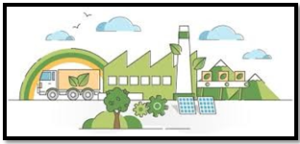FIRED UP AND PLUGGED IN
Relevance:
GS 3
- Conservation, environmental pollution and degradation, environmental impact assessment.
Why in News:
India’s efforts to decarbonize its power sector while fostering economic growth and ensuring energy security has been in focus.
Source- Hindustan Times
As India aims to become the fastest-growing economy in the coming years, it faces the challenge of transitioning away from unabated coal use, in line with a global commitment made at COP-28. This pivotal decade will scrutinize India’s efforts to decarbonize its power sector while fostering economic growth and ensuring energy security.
India’s Economic Growth and Global Climate Commitments:
- As India accelerates towards becoming the fastest-growing economy, it faces the challenge of growing sustainably, aligning with the COP-28 agreement to reduce dependence on unabated coal.
- This pivotal decade focuses on decarbonizing India’s power sector while ensuring continued economic progress and maintaining energy security.
India’s Climate Actions and Challenges:
- Positioned as the seventh most climate-vulnerable country, India proactively combats climate change, evidenced by a 76% reduction in fossil fuel subsidies between FY14 and FY22.
- Ambitious goals are set to nearly triple its renewable power generation capacity by 2030.
- Despite these strides, over 100 GW of base power load is still supported by coal-based power plants on most days, highlighting the complexity of transitioning from coal amidst escalating electricity demands.
Strategies for Decarbonizing While Ensuring Energy Security:
Enhancing Thermal Plant Efficiency:
- Addressing ~38 GW of coal-based power plant outages during peak demand times is crucial.
- Better demand forecasting and maintenance planning can improve plant availability, reducing the need for new thermal assets.
Flexibilizing Coal Power Plants:
- Adapting existing coal plants to accommodate the intermittent nature of renewable energy is necessary.
- Initiatives are underway to retrofit a significant portion of coal and lignite-based capacity, aiming to reduce emissions and integrate renewable energy smoothly.
Promoting Energy Storage Solutions
- Recognizing the critical role of energy storage in balancing renewable energy supply, standalone battery energy storage systems (BESS) and ’round-the-clock’ bids are gaining traction.
- Proper compensation for the grid-stabilizing contributions of BESS is advocated to encourage their adoption.
Fostering Self-Reliance in Energy Technology:
- The coal sector’s contribution to domestic value creation, job market, and ‘atmanirbhar’ (self-reliant) goals is substantial.
- Efforts are being made to boost domestic value addition in renewable energy sectors through initiatives like the PLI scheme, aiming for significant domestic and export contributions in the coming decade.
Balancing Decarbonization with Domestic Energy Needs:
- India’s focus on energy security is paramount as it navigates the path of decarbonization and renewable energy adoption.
- Policymakers are urged to evaluate the long-term costs of conventional energy reliance against the backdrop of falling renewable and storage prices.
- Ensuring affordable electricity access while progressively committing to more stringent decarbonization goals is the envisioned strategy for India’s energy future.
India’s energy journey in the next decade will be a story of balancing growth ambitions with environmental consciousness. By optimizing existing assets, embracing flexibility, investing in storage, and prioritizing local manufacturing, India can navigate this path effectively. With a focus on energy security as the foundation, India will be well-positioned to unlock a sustainable and green future.
| Key Outcomes of COP 28 (2023):
Global Stocktake (GST): · A review mechanism under the Paris Agreement. · Aims to limit global temperature rise to 1.5 degrees Celsius. · Calls for tripling global renewable energy capacity and doubling energy efficiency by 2030. · Focuses on reducing non-CO2 emissions, particularly methane, by 2030. Transitioning from Fossil Fuels: · Urges a just and orderly shift away from fossil fuels. · Accelerates actions for achieving net-zero emissions by 2050. Global Goal on Adaptation (GGA): · Enhances adaptive capabilities and minimizes vulnerability. · Calls for doubling adaptation finance and sets 2030 targets for water security, ecosystem restoration, and health. Climate Finance: · Aims to address the USD 500 billion owed by wealthy nations to developing countries. · Seeks a new climate finance goal with USD 100 billion per year, covering mitigation, adaptation, and loss and damage. Loss and Damage Fund: · Operationalizes a fund to compensate countries impacted by climate change. · Allocates specific percentages for Least Developed Countries and Small Island Developing States. · Initial oversight by the World Bank. · Global Renewables and Energy Efficiency Pledge: · Commits to tripling global renewable energy capacity to 11,000 GW by 2030. · Targets doubling the annual energy efficiency improvement rate to over 4% by 2030. Global Cooling Pledge: · Involves 66 national governments working to reduce cooling-related emissions by 68% by 2050. Declaration to Triple Nuclear Energy: · Aims to triple global nuclear energy capacity by 2050. Major Engagements of India in COP 28: Green Credit Initiative: · Encourages pro-environment actions. · Issues Green Credits for land restoration and ecosystem revival. LeadIT 2.0 (Leadership Group for Industry Transition): · Focuses on just industry transition and low-carbon technology transfer. · Provides financial support to emerging economies. Global River Cities Alliance (GRCA): · Led by India’s National Mission for Clean Ganga (NMCG). · Promotes river-centric development and climate resilience. · Facilitates knowledge exchange and best practices dissemination. Quad Climate Working Group (QCWG) on Localised Climate Action: · Recognizes the role of local communities and regional governments. · Supports sustainable lifestyles and climate action at the grassroots level. |
Source
The Hindu
Mains Question
Q “Discuss the challenges and strategies involved in India’s transition from coal-based power to a more renewable energy-intensive power sector. Highlight the significance of efficient thermal plant management, coal fleet flexibility, incentivizing energy storage services, and indigenizing clean energy supply chains in achieving this transition.”

 Source- Hindustan Times
Source- Hindustan Times


